It looks like you're using an Ad Blocker.
Please white-list or disable AboveTopSecret.com in your ad-blocking tool.
Thank you.
Some features of ATS will be disabled while you continue to use an ad-blocker.
share:
First look at this high res picture.. it does not shows up here as good.
www.nasa.gov...
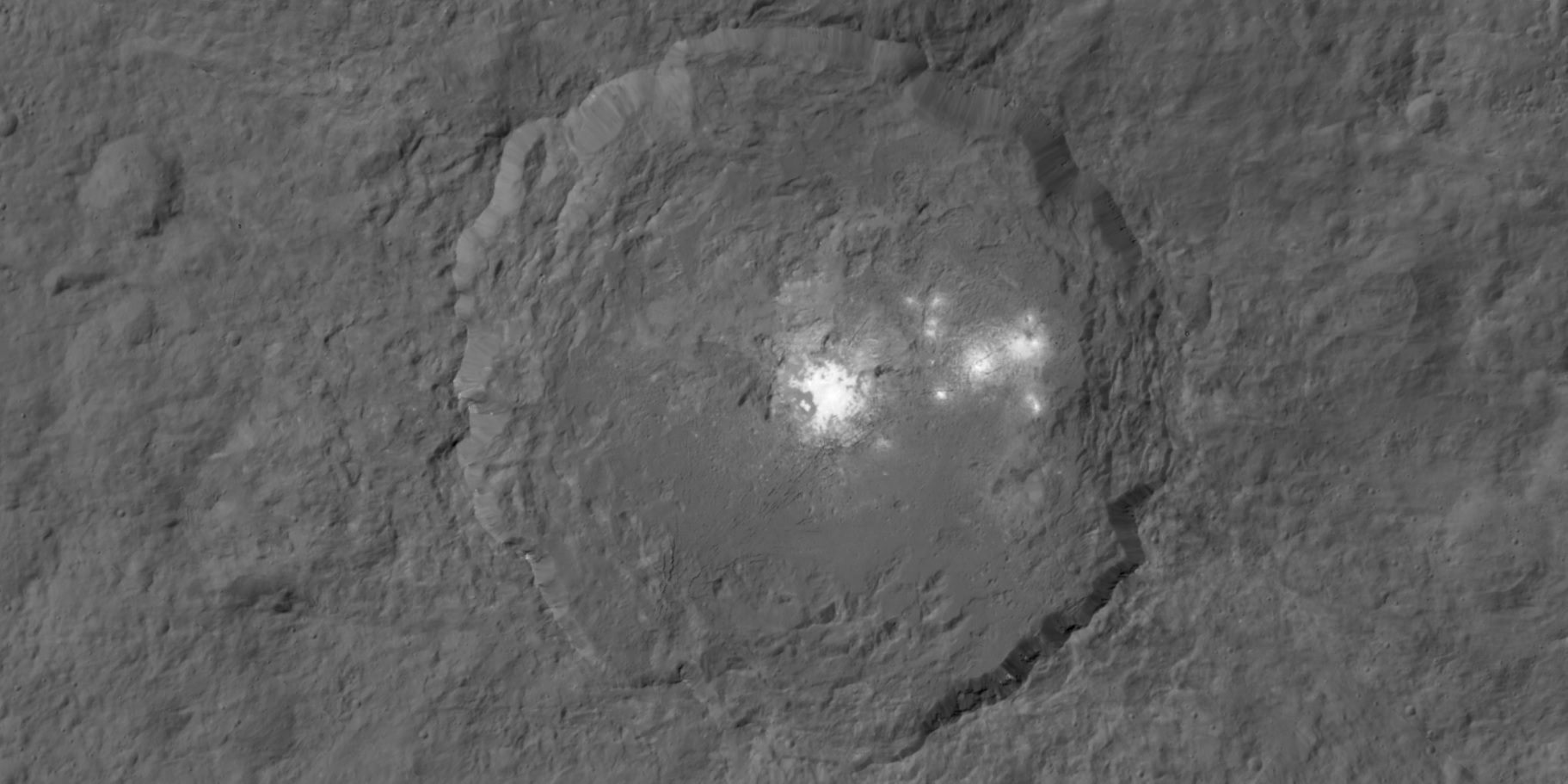
Inverted
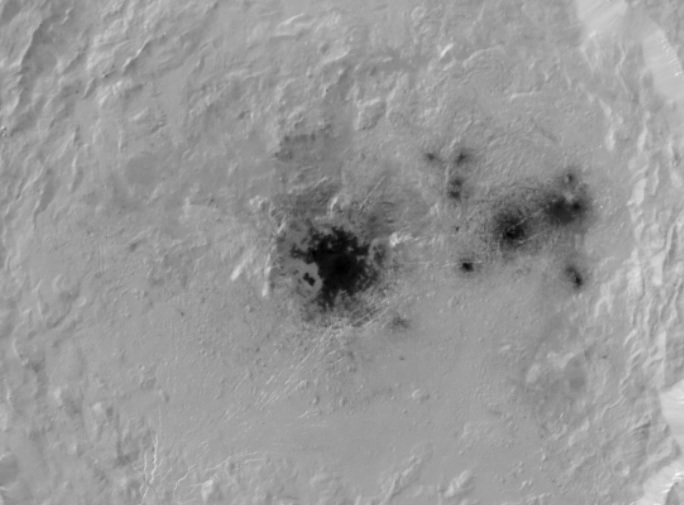
Contrast
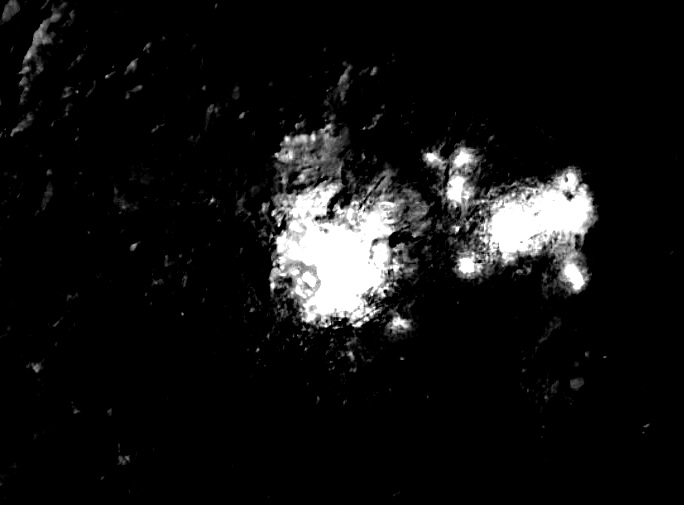
Link to raw high res picture
www.nasa.gov...
Link to Story
www.nasa.gov...
www.nasa.gov...
NASA have no idea what it is and is even asking the viewers what they think here:
www.jpl.nasa.gov...
cast your vote..
www.nasa.gov...

Inverted

Contrast

Link to raw high res picture
www.nasa.gov...
Link to Story
www.nasa.gov...
This mosaic shows Ceres' Occator crater and surrounding terrain from an altitude of 915 miles (1,470 kilometers), as seen by NASA's Dawn spacecraft. Occator is about 60 miles (90 kilometers) across and 2 miles (4 kilometers) deep.
www.nasa.gov...
NASA's Dawn spacecraft fired up its ion engine on Friday, Oct. 23, to begin its journey toward its fourth and final science orbit at dwarf planet Ceres. The spacecraft completed two months of observations from an altitude of 915 miles (1,470 kilometers) and transmitted extensive imagery and other data to Earth.
The spacecraft is now on its way to the final orbit of the mission, called the low-altitude mapping orbit. Dawn will spend more than seven weeks descending to this vantage point, which will be less than 235 miles (380 kilometers) from the surface of Ceres. In mid-December, Dawn will begin taking observations from this orbit, including images at a resolution of 120 feet (35 meters) per pixel.
Of particular interest to the Dawn team is Occator crater, home to Ceres' bright spots. A new mosaic of images from Dawn's third science orbit highlights the crater and surrounding terrain.
NASA have no idea what it is and is even asking the viewers what they think here:
www.jpl.nasa.gov...
cast your vote..
edit on 27-10-2015 by Spacespider because: (no reason given)
Wowzers, great quiality and rezolution. As this is a mosaic, the original image with the spots should provide an even better resolution.
Here's an enlarged and enhanced part of the mosaic:
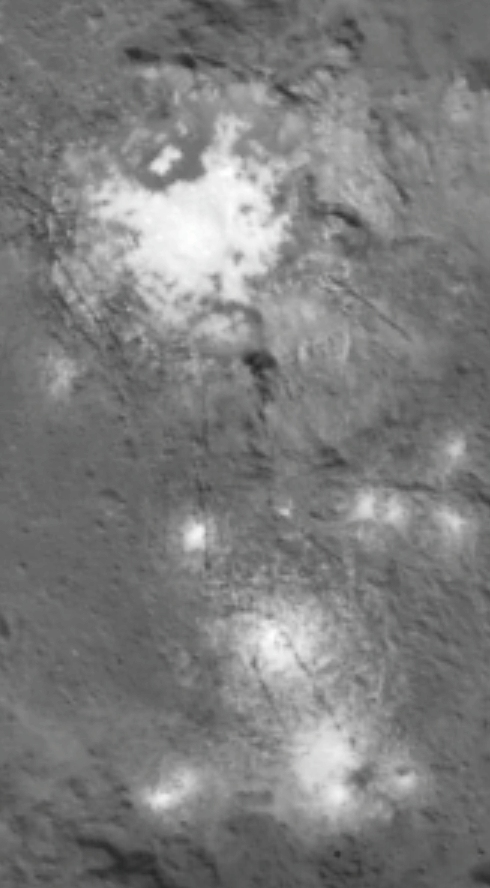
Looks very much like evaporated salt to me.
Here's an enlarged and enhanced part of the mosaic:

Looks very much like evaporated salt to me.
a reply to: Spacespider
Great pics thanks for posting..
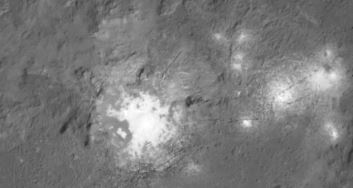
M or W ?
The vote so far..

Great pics thanks for posting..

M or W ?
The vote so far..

edit on 27 10 2015 by skywatcher44 because: Added
edit on 27 10 2015 by skywatcher44 because:
Added
whatever the deposits are, it is definitely not the deeper strata of Ceres.... the stuff came from a solo mass which broke up and there was two large
bodies with a debris trail to hit inside that already ancient crater
whatever the material was--- It left a field of brighter surface material and no 'deep' impact craters
large mineral or ice/salt snowballs ?
instead of stony meteors or asteroids is my guess...
so punch me in as 'Other' on your survey board
whatever the material was--- It left a field of brighter surface material and no 'deep' impact craters
large mineral or ice/salt snowballs ?
instead of stony meteors or asteroids is my guess...
so punch me in as 'Other' on your survey board
edit on th31144597562527532015 by St Udio because: (no reason given)
a reply to: Spacespider
Great picture , it looks volcanic to me but I've no idea what has been ejected.
Great picture , it looks volcanic to me but I've no idea what has been ejected.
My guess is still that it's a comet that splatted straight onto the surface. You'll be able to recreate this sort of pattern by throwing snowballs at
tree trunks. You usually end up with a snowpeak d at the middle and some smaller splats around or below this peak.
a reply to: wildespace
Looking at your zoom in, looks like there are fracture lines.
Might be impact or eruption cracks?
Looking at your zoom in, looks like there are fracture lines.
Might be impact or eruption cracks?
a reply to: Spacespider
Find the new tif here, blow it up to 300dpi and have some fun:
dawn.jpl.nasa.gov...
A few months ago we've got this:
www.nasa.gov...
Now we get this mosaic with more surroundings, fine.
Funny thing is, that the black triangle next to the big bright spot is gone.
Not gone exactly, just somewhere else by now. And some others showed up as well.
I guess NASA didn't comment on that?
Some parts look retouched and different compared to the old pic.
There is live on Ceres and we've been lied to once agian. Screw you, NASA!
Find the new tif here, blow it up to 300dpi and have some fun:
dawn.jpl.nasa.gov...
A few months ago we've got this:
www.nasa.gov...
Now we get this mosaic with more surroundings, fine.
Funny thing is, that the black triangle next to the big bright spot is gone.
Not gone exactly, just somewhere else by now. And some others showed up as well.
I guess NASA didn't comment on that?
Some parts look retouched and different compared to the old pic.
There is live on Ceres and we've been lied to once agian. Screw you, NASA!
Looks like Chalk ? No not on Ceres surely . I can see other bright spots around when zooming in 3.20 o'clock ish ( two spots ) and 5 o'clock ish 3/4
spots near the edge.
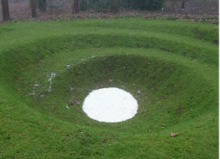
www.geologyshop.co.uk...

www.geologyshop.co.uk...
edit on 27 10 2015 by skywatcher44 because: Not a moon of Pluto. Ha
originally posted by: PublicOpinion
Funny thing is, that the black triangle next to the big bright spot is gone.
Not gone exactly, just somewhere else by now. And some others showed up as well.
I guess NASA didn't comment on that?
Some parts look retouched and different compared to the old pic.
There is live on Ceres and we've been lied to once agian. Screw you, NASA!
Instead of cursing at NASA, how about I curse at you for not noticing that the "black triangle" is a problem with the camera which appears in the same spot in each raw image?
photojournal.jpl.nasa.gov...
photojournal.jpl.nasa.gov...
photojournal.jpl.nasa.gov...
photojournal.jpl.nasa.gov...
Don't jump to conclusions that NASA is lying, lest you make yourself look like a fool.
a reply to: ngchunter
Thanks for the accusation, I thought about that. You're right on track, just walk a little further with me now.
Thing is, your observation is quite correct. This triangle appeared in the old picture together with another black square and a round shape, you'll see all 3 of them in the new mosaic as well. But triangle and square are missing inside the crater in that new pic. Just the round shape is still there, at the same position slightly outside the crater east from the little bright spots.
This central piece would be the only picture in the mosaic without triangle & square marks, but with it's round feature. Tricky, innit? Why are they gone now, any explanations? That's right, I don't have one either. Except the one you don't like, of course.
Thanks for the accusation, I thought about that. You're right on track, just walk a little further with me now.
Thing is, your observation is quite correct. This triangle appeared in the old picture together with another black square and a round shape, you'll see all 3 of them in the new mosaic as well. But triangle and square are missing inside the crater in that new pic. Just the round shape is still there, at the same position slightly outside the crater east from the little bright spots.
This central piece would be the only picture in the mosaic without triangle & square marks, but with it's round feature. Tricky, innit? Why are they gone now, any explanations? That's right, I don't have one either. Except the one you don't like, of course.
edit on 27-10-2015 by PublicOpinion because: live on Ceres
edit on 27-10-2015 by PublicOpinion because: (no reason
given)
Have we just found el knabnaper's cosmic coc aine stash? Oh no, he could get in real big trouble with the intergalactic federation of light.
Looks like he tried to drop it off all smooth like but the big bubble leaked and it splattered all over the shop. Someone call Blossom Goodchild immediately!
Looks like he tried to drop it off all smooth like but the big bubble leaked and it splattered all over the shop. Someone call Blossom Goodchild immediately!
edit on 11/10/2012 by Joneselius because: (no reason given)
I would be curious to hear what the thunderbolts guys would say about this.
Based on what we know about the composition of Pluto's surface, what would be the likely result of superheating that material from a plasma discharge?
Is it silica and therefore maybe glass like when a lightning bolt strikes the sand?
Based on what we know about the composition of Pluto's surface, what would be the likely result of superheating that material from a plasma discharge?
Is it silica and therefore maybe glass like when a lightning bolt strikes the sand?
originally posted by: PublicOpinion
a reply to: ngchunter
But triangle and square are missing inside the crater in that new pic.
Are you really this dense? Really? The triangle was in the same position in each of the RAW images I showed you, it's a camera problem, not a real object. The new image is a mosaic of multiple exposures, NOT a RAW image. Do you not understand the difference there? You have no way of knowing where the triangle should be in the new images, if it even persists at all, or if multiple exposures were used to collect the data from the missing triangle in the image.
originally posted by: PublicOpinion
Why are they gone now, any explanations? That's right, I don't have one either.
There you go again, jumping to conclusions. Yes, explanation above. Perhaps you should have just asked an honest question instead of trying to make NASA look like liars and in the process make yourself look like a fool.
a reply to: ngchunter
I beg to differ, you're speculating and don't seem to be aware what you're talking about. Guess it never crossed your mind to compare this new mosaic with the old pic?
How do you explain the things I mentioned in my last post, did you actually read it? You really think this central piece is a new image?
Agreed to disagree.
A self-proclaimed NASA-Paladin, eh? Go ahead and patronize me, who on Ceres cares? Looks don't matter at all if you're unable to address at least one of my points. What is this, a friggin joke?
Thanks for the fish and obey a nice day!
You have no way of knowing where the triangle should be in the new images, if it even persists at all, or if multiple exposures were used to collect the data from the missing triangle in the image.
I beg to differ, you're speculating and don't seem to be aware what you're talking about. Guess it never crossed your mind to compare this new mosaic with the old pic?
How do you explain the things I mentioned in my last post, did you actually read it? You really think this central piece is a new image?
Agreed to disagree.
you should have just asked an honest question instead of trying to make NASA look like liars and in the process make yourself look like a fool
A self-proclaimed NASA-Paladin, eh? Go ahead and patronize me, who on Ceres cares? Looks don't matter at all if you're unable to address at least one of my points. What is this, a friggin joke?
Thanks for the fish and obey a nice day!
I guess we can't look at one single celestial body without someone screaming aliens. It wasn't that long ago the notion of the outer planets or
various moons having any type of geologic activity laughable. Everywhere we look from Mars to Ceres appears to have some historic and current geologic
activity, whether flowing water or frozen methane geysers.
Isn't that amazing enough? Do we really need aliens contaminating everything?
It would be cool to discover it's an active volcano of sorts.
Isn't that amazing enough? Do we really need aliens contaminating everything?
It would be cool to discover it's an active volcano of sorts.
edit on 28-10-2015 by Rosinitiate because: (no reason given)
originally posted by: PublicOpinion
I beg to differ, you're speculating and don't seem to be aware what you're talking about.
It's not speculation, it's a fact, one is a set of raw images which I gave you, the other is a processed stitched mosaic of multiple exposures with indeterminate camera orientation and overlap. The triangle is still there in the stitched mosaic, but in different locations because it's composed of multiple exposures in different orientations than the original raw image from the previous passes.
Guess it never crossed your mind to compare this new mosaic with the old pic?
It's a ridiculous comparison because you're comparing apples and oranges. One is a raw image, the other is a mosaic, do you not understand this?
How do you explain the things I mentioned in my last post, did you actually read it? You really think this central piece is a new image?
Agreed to disagree.
I'm not agreeing to disagree, you are ignoring the fundamental facts of the situation.
A self-proclaimed NASA-Paladin, eh? Go ahead and patronize me, who on Ceres cares? Looks don't matter at all if you're unable to address at least one of my points. What is this, a friggin joke?
I tore your entire argument apart since it rests entirely upon a STITCHED PROCESSED MOSAIC vs RAW IMAGES!
edit on 28-10-2015 by ngchunter
because: (no reason given)
edit on 28-10-2015 by ngchunter because: (no reason given)
new topics
top topics
-
Federal law trumps state and local law every time
Social Issues and Civil Unrest: 17 hours ago, 17 flags
active topics
-
Petition Calling for General Election at 564,016 and rising Fast
Political Issues • 94 • : Freeborn -
-@TH3WH17ERABB17- -Q- ---TIME TO SHOW THE WORLD--- -Part- --44--
Dissecting Disinformation • 3384 • : brewtiger123 -
BIDEN Admin Begins Planning For January 2025 Transition to a New President - Today is 4.26.2024.
2024 Elections • 59 • : WeMustCare -
DOJ Special Counsel Robert HUR Says JOE BIDEN Can Be ARRESTED After Jan 20th 2025.
Above Politics • 30 • : WeMustCare -
On Nov. 5th 2024 - AMERICANS Prevented the Complete Destruction of America from Within.
2024 Elections • 160 • : WeMustCare -
Results of the use of the Oreshnik missile system in Dnepropetrovsk
World War Three • 240 • : 777Vader -
Both KAMALA and OBAMA are on the Nov 5th 2024 Ballot - If One Loses - Both Lose.
2024 Elections • 9 • : WeMustCare -
How many people, in GENERAL, are musically inclined?
Music • 26 • : Huronyx -
Well, here we go red lines crossed Biden gives the go ahead to use long range missiles
World War Three • 395 • : annonentity -
Federal law trumps state and local law every time
Social Issues and Civil Unrest • 30 • : ADVISOR
